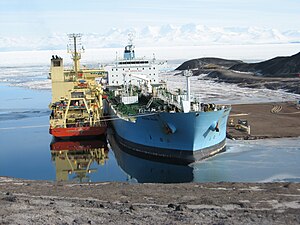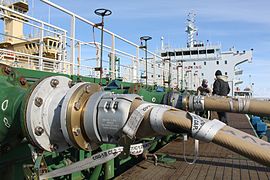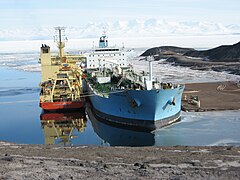
The United States Merchant Marine is composed of United States civilian mariners and U.S. civilian and federally owned merchant vessels. Both the civilian mariners and the merchant vessels are managed by a combination of the government and private sectors, and engage in commerce or transportation of goods and services in and out of the navigable waters of the United States. The Merchant Marine primarily transports domestic and international cargo and passengers during peacetime, and operate and maintain deep-sea merchant ships, tugboats, towboats, ferries, dredges, excursion vessels, charter boats and other waterborne craft on the oceans, the Great Lakes, rivers, canals, harbors, and other waterways. In times of war, the Merchant Marine can be an auxiliary to the United States Navy, and can be called upon to deliver military personnel and materiel for the military.

Military Sealift Command (MSC) is an organization that controls the replenishment and military transport ships of the United States Navy. Military Sealift Command has the responsibility for providing sealift and ocean transportation for all US military services as well as for other government agencies. It first came into existence on 9 July 1949 when the Military Sea Transportation Service (MSTS) became solely responsible for the Department of Defense's ocean transport needs. The MSTS was renamed the Military Sealift Command in 1970.

McMurdo Sound, a sound in Antarctica, is the southernmost navigable body of water in the world, located approximately 1,300 kilometres (810 mi) from the South Pole.
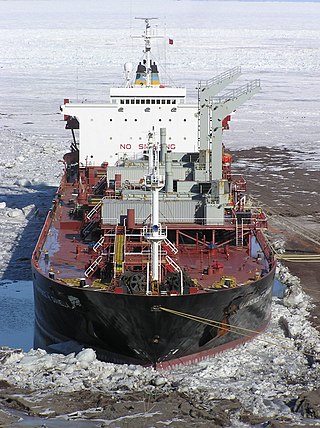
USNS Lawrence H. Gianella (T-AOT-1125) is a United States Military Sealift Command product tanker which typically carries diesel, gasoline, and JP5.

USNS Richard E. Byrd (T-AKE-4) is a Lewis and Clark-class dry cargo ship in the United States Navy. She is the second United States Navy ship to be named after polar explorer Rear Admiral Richard E. Byrd (1888–1957).
Several ships of the United States Navy have been named Peary or Robert E. Peary, after Robert E. Peary (1856–1920), the Arctic explorer.

An ice pier or ice wharf is a man-made structure used to assist the unloading of ships in Antarctica. It is constructed by pumping seawater into a contained area and allowing the water to freeze. By repeating this procedure several times, additional layers are built up. The final structure is many metres in thickness, and strong enough to support container trucks. Operation Deep Freeze personnel constructed the first floating ice pier at Antarctica’s southernmost sea port at McMurdo Station in 1973. Ice piers have been in use each summer season since, at McMurdo's natural harbor at Winter Quarters Bay located at 77°50′S166°40′E. The harbor is positioned on the southern tip of Ross Island.

MV Shughart (T-AKR-295) is the lead ship of her class of cargo ships operated by the United States Navy. She is a 'roll-on roll-off' non-combat vessel designated as a "Large, Medium-Speed Roll-on/Roll-off" (LMSR) ship.

MV Transpacific, also known as Bonito, also known as Turcas II, also known as Nikolay Shalavin (2001) is an oil tanker under long-term charter to the United States Military Sealift Command (MSC). As part of MSC's Sealift Program, the Transpacific transports fuel for the U.S. Department of Defense. Small and having shallow-draft, the Transpacific is known as a T-1 equivalent tanker, and moves petroleum products intra-theater in between Japan, Korea and The Marshall Islands.
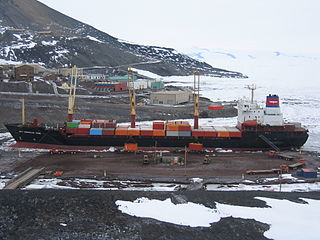
MV American Tern (T-AK-4729) is a container ship managed by APL Maritime. Formerly the Liberian-flagged Kariba, the vessel was renamed American Tern under the United States flag in 2002. Since then, the American Tern has been chartered by the United States Navy Military Sealift Command. She was contracted through 2010 to make resupply voyages to McMurdo Station in Antarctica and Thule Air Base in Greenland. The vessel is named after the tern, a type of bird that makes annual migrations from the Arctic to the Antarctic.

USNS Maumee (T-AO-149), later T-AOT-149, was a United States Navy Maumee-class oiler, later transport oiler, in non-commissioned service with the Military Sea Transportation Service (MSTS), later Military Sealift Command, from 1956 until probably the mid-1980s.

MV Kalia is a small double-hulled oil tanker managed by Adminros Shipmanagement Company, Ltd. and registered under the flag of Cyprus. The 109-meter-long ship has a nominal crew of 13 and can carry 30,000 barrels (4,770 m3) of oil. While known as the MV Montauk, the ship was owned by the American company Sealift Incorporated, and sailed under long-term charter to the United States Military Sealift Command where it transported oil for the U.S. Department of Defense.

Enrica Lexie is an Italian Aframax oil-tanker. In 2012, the ship was involved in the shooting of two Indian fisherman in the Laccadive Sea.

USNS Yano (T-AKR-297) was originally constructed as the container ship Leise Maersk in 1980. In 1987, the ship was lengthened and again in the 1990s before it was purchased by the United States Navy. When the transfer was complete, the ship underwent a conversion to a large, medium-speed, roll-on/roll-off ship at NASSCO.
The International Code for Ships Operating in Polar Waters or Polar Code is an international regime adopted by the International Maritime Organization (IMO) in 2014. The Code sets out regulations for shipping in the polar regions, principally relating to ice navigation and ship design. The international framework aims to protect the two polar regions — the Arctic and Antarctic, from maritime risks. The Code entered into force on 1 January 2017.
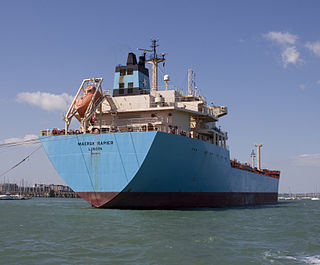
MV Maersk Rapier is a commercial product tanker that was owned by the A.P. Moller–Maersk Group and chartered to the United Kingdom's Ministry of Defence (MoD). The vessel served as the primary strategic link for the collection and transportation of purchased fuel from oil refineries to British and NATO fuel depots.
Groupe Desgagnés is a Canadian shipping firm. It operates a fleet of nineteen vessels. Gross earnings in 2014 were around $230 million.
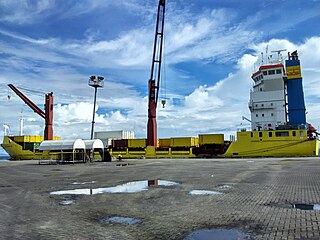
MV Span Asia 25 is a container vessel owned and operated by the Philippine Span Asia Carrier Corporation (PSACC). She is the former Heidi B up until September 1994, Maersk Euro Quinto until May 1997, Helgafell up until March 2005, Seaboard Rio Haina up until June 2008, Rio Bogota until December 2009, and Mohegan up until 2016. She was built at Orskov Shipbuilders Yard - Frederikshavn, Denmark in 1994 with IMO number 9100243 and MMSI number 54840200. She has a tonnage of 6158 tons. Her deadweight is 7850 tons and has a length of 121.9 m and beam of 20.1 m.
